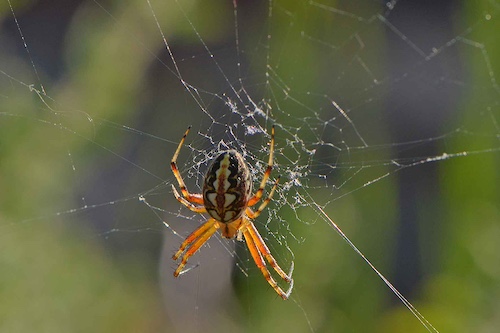Sometimes it feels like I live in a nightmare. In the morning when I leave the house I have to arm myself with a broom in order to break through all the cobwebs around the house, for fear of changing into a silk cocoon. But I count my blessings that a spider does not exist who can imitate the artist Christo who used to wrap up entire buildings.
An orgy
Just imagine this. On a beautiful morning in 2018 , at the bay of the little Greek town of Aitoliko— the entire landscape, inclusive of boats, was buried under a spiderweb of some 300 meters long. Creepy!
This was the work of long-jawed orb-weavers (Tetragnatha) who organized a huge orgy with a full banquet of insects, as the warm temperatures and high humidity were ideal. I bet there was a lot of sex that night, creating a whole new generation of spiders. But it must be said that these eight-legged creeps do not harm anybody and even nature does not get hurt.
I was happy to read that a cobweb does not harm plants. My garden is not covered by an enormous web, but part of the plants have been annexed as hunting grounds by lots of spiders. It would take me hours to get rid of all the spiderwebs; and of course the spiders weave them again in the night. There are even spiders that love so much a spotless web that each night they eat the old web full of protein in order to start the day with a brand new system of wires.
The making of spiderwebs
Lots of spiders produce a silk thread, leaving it waving in the wind until it finds a place to stick. Then that thread is made stronger by walking over it and by spinning yet more arms. They throw more threads to create more supporting points and this way they weave a dangerous net for their enemies.
The best known spiderweb is the orb web, pretty photogenic in the right light and especially with dew drops: ideal to catch mosquitos and other flying vermin. There are mat and funnel webs, layered webs, set low to the ground, where insects get stuck —especially dangerous for grasshoppers. Or messy looking gallow webs that catch their prey with a sticky wire that then catapults it into the web.
A wonderful spider world
Not all spiders use webs for culinary purposes. There are spiders that make air balloons with their webs so that they can travel on the wind, they play Tarzan by using wires as lianas so that they can swing around in the woods and there are spiders that build houses underwater. The silk wires can be used to make nests, to cover a victim in order to preserve it or decorate the walls of their homes. The more you read about them, the more you wonder about this wonderful spider world.
People are jealous of the silk spinning. Scientist haven’t yet discovered all the secrets of spiderwebs. For example the threads, a combination of different proteins, are stronger than steel.
Clothes from spider silk
It took textile designer Simon Peers and entrepreneur Nicholas Godley fifteen year’s research, eight years of production time and more than two million orb-weaver spiders (Nephila) to make clothes of spider silk. About 80 people were needed daily to catch the spiders in the highlands of Madagascar; these spiders then produced 30 to 50 meter of thread in the laboratory, thereafter they were returned unharmed to their habitat. The silk was installed on looms and this way a traditional dress of Madagascar (lamba) and shawls were made, in a natural, warm, gold yellow color. Fairy tale like pieces for a museum.
Less mosquitos, less grasshoppers
The spiderwebs that cause so much cleaning misery outside of my house, and that also indoors try to take over the household, do not have this breathtaking yellow color. Plants, outside furniture, windows, in fact everything the spiders can find is being incapsulated night after night by transparent to white threads. Most webs belong to the free style spiderwebs, because not all can be placed into the categories named above.
Some spiders, especially when they are big, dark and hairy, I still fear, even though humans are not on their hit list. They mainly seek out insects, like mosquitos. That is why we should have more respect for them and their artworks: the more spiderwebs, the less mosquitos, grass hoppers and god knows what other creeps they usually collect. But I still won’t go out in the morning without a broom.











